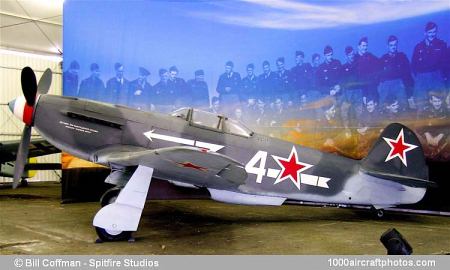09/30/2011. Early in 1941, the Yak-3 was conceived to meet a specific Soviet AF requirement for an exceptionally agile single-seat fighter capable of maximum performance at low altitude and suitable for maintenance of aerial superiority in the immediate vicinity of the battlefield. The Yak-3 appeared in Soviet AF service in the summer of 1944 as the smallest and lightest warplane in its category to see large-scale operational service during World War II.
Originally intended to use the M-l07 engine, the Yak-3 (the designation being re-assigned from the defunct I-30 program) was developed via a modified Yak-1M which, fitted with a smaller wing, was flown on February 28, 1943. Further refinement of the aircraft undertaken by Konstantin V Sinelshchikov led to the oil cooler air intake sharing wing root positioning with those for the carburetor and supercharger.
Non-availability of the M-l07A engine led to adoption of the M -105PF -2, which, operating at higher revolutions than the PF-l version in the Yak-1M, afforded 1,300 hp at 2,625 ft (800 m). Armament consisted of one engine-mounted 0.787 in (20 mm) ShVAK cannon and two 0.50 in (12.7 mm) UBS machine guns.
The development program was delayed when the prototype Yak-3 suffered a structural failure, full State Acceptance trials not being completed until October 1943, by which time a small pre-series was under construction at GAZ 286 at Kamensk Ural'ski. These were immediately assigned on completion to an operational regiment for service trials, and, in the event, saw combat during the Soviet counter-offensive to Operation Zitadelle.
Despite the success of these combat trials, the Yak-3 was not officially cleared by the Soviet AF for production until June 1944, but the 91st IAP (Fighter Regiment) had re-equipped with this type by July, and, on the 16th of that month, was able to claim destruction of 24 Bf 109 Gs and Fw 190s in one low-altitude melee involving 18 of the IAP's Yak-3s. Virtually simultaneously, the French Norrnandie-Niemen regiment at the Eastern Front began re-equipping with the Yak-3.
The basic Yak-3 was the subject of considerable experimentation, test variants including the Yak-3RD fitted with a so-called "auxiliary accelerator" in the form of a Glushko RD-l (KhZ) bi-fuel (nitric acid and kerosene) rocket motor in the tail. A speed of 498 mph (801 kmh) was attained with the aid of this rocket while in a shallow climb, but on August 16, 1944, the Yak-3RD was lost when the rocket exploded.
Second-generation Yak-3s were evolved with M-l07 and M-l08 engines, but these were not to achieve large-scale production, contributing comparatively few to the total of 4,848 of this fighter that had been delivered in eighteen variants when production ended at the beginning of 1946. Despite the large production number, reportedly only four of the single-seat fighter version still exist.
When the French Normandie-Niemen regiment returned to France after WW II, Stalin donated forty aircraft to France. The last was withdrawn from service in 1956, and one survived at the Le Bourget museum. Pictured in a fairly good condition in the Normandie-Niemen Memorial display in the WW II hangar of the museum, the aircraft was removed from display in April 2011 in a lesser condition and subsequently stored. In due time it reportedly will be restored and put on display again.
